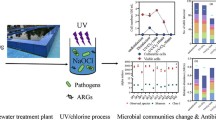Abstract
Isolation of most ultraviolet B (UV-B)-resistant culturable bacteria that occur in the habitat of Laguna Azul, a high-altitude wetland [4554 m above sea level (asl)] from the Northwestern Argentinean Andes, was carried out by culture-based methods. Water from this environment was exposed to UV-B radiation under laboratory conditions during 36 h, at an irradiance of 4.94 W/m2. It was found that the total number of bacteria in water samples decreased; however, most of the community survived long-term irradiation (312 nm) (53.3 kJ/m2). The percentage of bacteria belonging to dominant species did not vary significantly, depending on the number of UV irradiation doses. The most resistant microbes in the culturable community were Gram-positive pigmented species (Bacillus megaterium [endospores and/or vegetative cells], Staphylococcus saprophyticus, and Nocardia sp.). Only one Gram-negative bacterium could be cultivated (Acinetobacter johnsonii). Nocardia sp. that survived doses of 3201 kJ/m2 were the most resistant bacteria to UV-B treatment. This study is the first report on UV-B resistance of a microbial community isolated from high-altitude extreme environments, and proposes a method for direct isolation of UV-B-resistant bacteria from extreme irradiated environments.


Similar content being viewed by others
Literature Cited
Arrage AA, Phelps TJ, Benoit RE, White DC (1993) Survival of subsurface microorganisms exposed to UV radiation and hydrogen peroxide. Appl Environ Microbiol 59:3545–3550
Arrieta JM, Weinbauer MG, Herndl G (2000) Interspecific variability in sensitivity to UV radiation and subsequent recovery in selected isolates of marine bacteria. Appl Environ Microbiol 66:1468–1473
Azam F, Fenchel T, Field JG, Gray JS, Meyer-Reil LA, Thingstad F (1983) The ecological role of water-column microbes in the sea. Mar Ecol Prog Ser 10:257–263
Ferrero MA, Farias ME, Siñeriz F (2004) Preliminary characterization of microbial communities in High Altitude Wetlands of Northwestern Argentina by determining terminal restriction fragment length polymorphisms. Rev Latinoam Microbiol 46:72–79
Gascón J, Oubiña A, Pérez-Lezaun A, Urmeneta J (1995) Sensitivity of selected bacterial species to UV radiation. Curr Microbiol 30:177–182
Helbling EW, Marguet ER, Villafañe VE, Holm-Hansen O (1995) Bacterioplankton viability in Antarctic waters as affected by solar ultraviolet radiation. Mar Ecol Prog Ser 126:293–298
Jacobs JL, Sundin GW (2001) Effect of solar UV-B radiation on a phyllosphere bacterial community. Appl Environ Microbiol 67:5488–5496
Jeffrey WH, Aas P, Lyons MM, Coffin RB, Pledger RJ, Mitchell DL (1996) Ambient solar radiation-induced photodamage in marine bacterioplankton. Photochem Photobiol 64:419–427
Joux F, Jeffrey WH, Lebaron P, Mitchell DL (1999) Marine bacterial isolates display diverse responses to UV-B radiation. Appl Environ Microbiol 65:3820–3827
Karsten U, Garcia-Pichel F (1996) Carotenoids and mycosporine-like amino acid compounds in members of the Genus Microcoleus (Cyanobacteria): A chemosystematic study. Systematic Appl Microbiol 19:285–294
La Duc MT, Nicholson W, Kern R, Venkateswaran K (2003) Microbial characterization of the Mars Odyssey spacecraft and its encapsulation facility Environ Microbiol 5:977–985
Link L, Sawyer K, Nicholson W (2004) Extreme spore UV resistance of Bacillus pumilus isolates obtained from an ultraclean Spacecraft Assembly Facility. Microb Ecol 47:159–163
Martin EL, Reinhardt RL, Baum LL, Becker MR, Shaffer JJ, Kokjohn TA (2000) The effects of ultraviolet radiation on the moderate halophile Halomonas elongata and the extreme halophile Halobacterium salinarum. Can J Microbiol 46:180–187
Nasim A, James AP (1978) Life under conditions of high irradiation. In: Kushner DJ (ed) Microbial life in extreme environments. New York: Academic Press, pp 409–439
Wilson C, Caton TM, Buchheim JA, Buchheim MA, Schneegurt MA, Miller RV (2004) DNA-repair potential of Halomonas spp. from the Salt Plains Microbial Observatory of Oklahoma. Microb Ecol 48:541–549
Acknowledgments
We thank Walter Helbling from EFPU for invaluable help in carrying out photobiology techniques in our laboratory; Dr. Javier Ochoa for his collaboration in statistical analyses; Geol. Fernando Lopez, for his assistance as a geologist and for driving Andeans roads, to “Chiche”; and Cristian, who rescued us in the cordillera truck incident. This work was supported by PEI-CONICET no. 6096, 6268, Fundación Antorchas no. 14248-133, PICT-Agencia Nacional de Promoción Científica y Tecnológica no. 14498, 13388. Verónica Fernandez Zenoff is a recipient of a CONICET fellowship.
Author information
Authors and Affiliations
Corresponding author
Additional information
This article is dedicated to the memory of Carolina Colin.
Rights and permissions
About this article
Cite this article
Zenoff, V.F., Heredia, J., Ferrero, M. et al. Diverse UV-B Resistance of Culturable Bacterial Community from High-Altitude Wetland Water. Curr Microbiol 52, 359–362 (2006). https://doi.org/10.1007/s00284-005-0241-5
Received:
Accepted:
Published:
Issue Date:
DOI: https://doi.org/10.1007/s00284-005-0241-5




